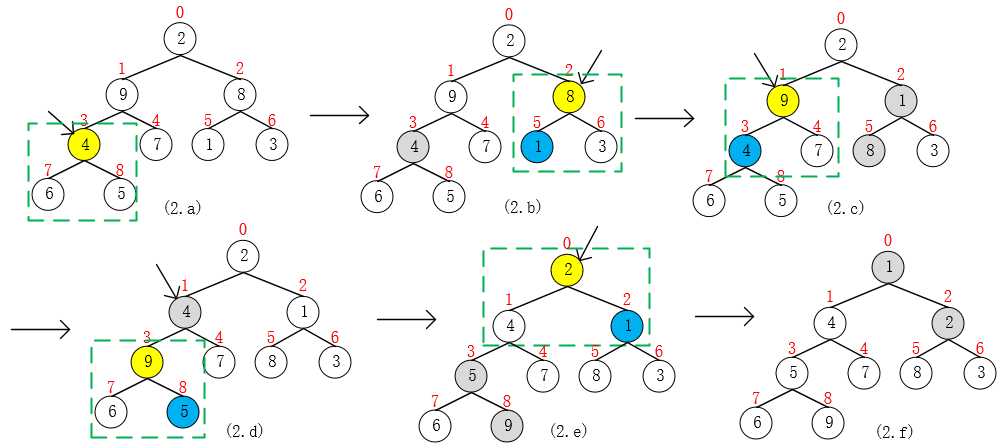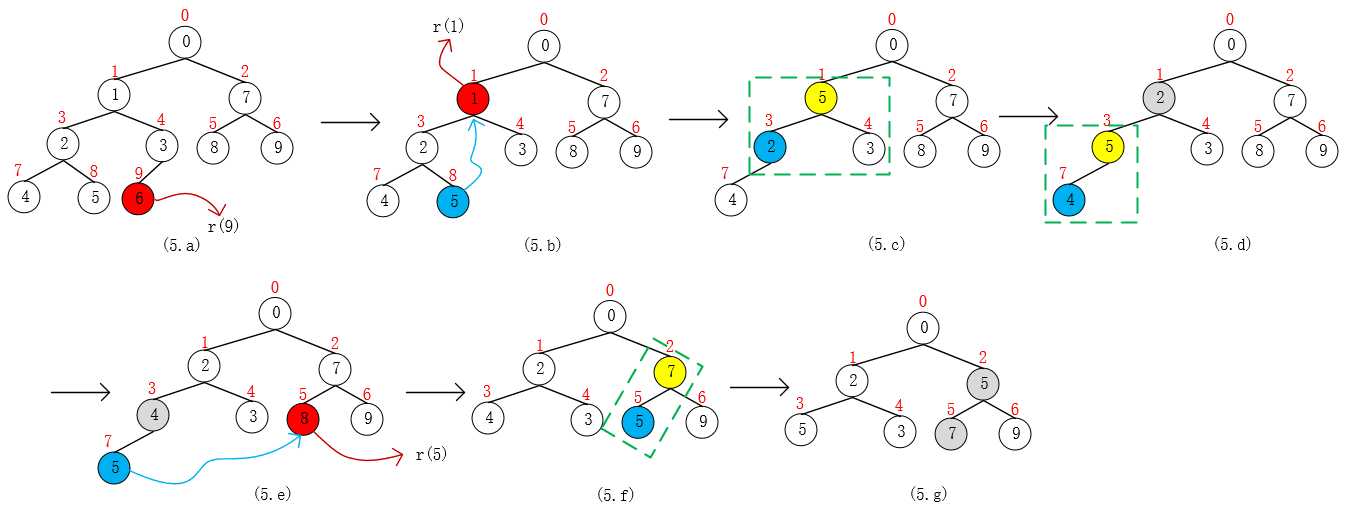标签:private nta 索引 coder nbsp equals 图片 length info
JDK 10.0.2
前段时间在网上刷题,碰到一个求中位数的题,看到有网友使用PriorityQueue来实现,感觉其解题思想挺不错的。加上我之前也没使用过PriorityQueue,所以我也试着去读该类源码,并用同样的思想解决了那个题目。现在来对该类做个总结,需要注意,文章内容以算法和数据结构为中心,不考虑其他细节内容。如果小伙伴想看那个题目,可以直接跳转到(小测试)。
我只列出了讲解需要的重要属性,不考虑其他细节。PriorityQueue(优先队列)内部是以堆来实现的。为了描述方便,接下来的内容我将用pq[ ]代替queue[ ]。
PriorityQueue<E> { /* 平衡二叉堆 用于存储元素 * n : 0 -> size-1 * pq[n].left = pq[2*n+1] * pq[n].right = pq[2*(n+1)] */ Object[] queue; int size; // pq中元素个数 Comparator<? super E> comparator; // 自定义比较器 }
如果使用已有集合来构造PriorityQueue,就会用到heapify()来对pq[ ]进行初始化(即:二叉堆化),使其满足堆的性质。而heapify()又通过调用siftDownComparable(k, e)来完成堆化。源码如下:

1 @SuppressWarnings("unchecked") 2 private void heapify() { 3 final Object[] es = queue; 4 int i = (size >>> 1) - 1; 5 if (comparator == null) 6 for (; i >= 0; i--) 7 siftDownComparable(i, (E) es[i]); 8 else 9 for (; i >= 0; i--) 10 siftDownUsingComparator(i, (E) es[i]); 11 } 12 13 @SuppressWarnings("unchecked") 14 private void siftDownComparable(int k, E x) { 15 Comparable<? super E> key = (Comparable<? super E>)x; 16 int half = size >>> 1; // loop while a non-leaf 17 while (k < half) { 18 int child = (k << 1) + 1; // assume left child is least 19 Object c = queue[child]; 20 int right = child + 1; 21 if (right < size && 22 ((Comparable<? super E>) c).compareTo((E) queue[right]) > 0) 23 c = queue[child = right]; 24 if (key.compareTo((E) c) <= 0) 25 break; 26 queue[k] = c; 27 k = child; 28 } 29 queue[k] = key; 30 }
如果有自定义比较器的话,调用:siftDownUsingComparator(k, e),否则调用:siftDownComparable(k, e)。这两个方法只是在比较两个元素大小时的表现形式不同,其他内容相同,所以我们只需要看其中一种情况就行。为了描述方便,下面的例子中,我使用Integer作为pq[ ]存储元素类型,所以调用的是siftDownComparable(k, e)。(size >>> 1 表示 size 无符号右移1位,等价于size / 2)
我不会去细抠源码,一行一行地为大家讲解,而是尽量使用简单的例子来展示,我觉得通过例子以及后期大家自己阅读源码,会更容易理解算法内容。
现在我们来看看,使用集合{2, 9, 8, 4, 7, 1, 3, 6, 5}来构造PriorityQueue的过程。算法时间复杂度为O(n),n = size。(时间复杂度证明:《算法导论》(第3版)第6章6.3建堆)

添加元素:add(e),offer(e),由于添加元素可能破坏堆的性质,所以需要调用siftUp(i, e)向上调整来维护堆性质。同样,siftUp(i, e)根据有无自定义比较器来决定调用siftUpUsingComparator(k, e)还是siftUpComparable(k, e)。在我举的例子中,使用的是siftUpComparable(k, e)。下面是添加元素的相关源码:

1 public boolean offer(E e) { 2 if (e == null) 3 throw new NullPointerException(); 4 modCount++; 5 int i = size; 6 if (i >= queue.length) 7 grow(i + 1); 8 siftUp(i, e); 9 size = i + 1; 10 return true; 11 } 12 13 @SuppressWarnings("unchecked") 14 private void siftUpComparable(int k, E x) { 15 Comparable<? super E> key = (Comparable<? super E>) x; 16 while (k > 0) { 17 int parent = (k - 1) >>> 1; 18 Object e = queue[parent]; 19 if (key.compareTo((E) e) >= 0) 20 break; 21 queue[k] = e; 22 k = parent; 23 } 24 queue[k] = key; 25 }
源码中 grow(i + 1) 是当pq[ ]容量不够时的增长策略,目前可以不用考虑。现在来看往最小堆 pq = {3, 5, 6, 7, 8, 9} 中添加元素 1的过程。算法时间复杂度为O(lgn),n = size。

indexOf(o)是个私有方法,但好多公开方法中都调用了它,比如:remove(o),contains(o)等,所以在这里也简单提一下。该算法并不复杂。时间复杂度为O(n),n = size。

1 private int indexOf(Object o) { 2 if (o != null) { 3 for (int i = 0; i < size; i++) 4 if (o.equals(queue[i])) 5 return i; 6 } 7 return -1; 8 }
indexOf(o)中比较两个元素是否相等,使用的是equals(),而接下来要提的removeEq(o)中直接使用了 == 来判断,请读者注意区别。
remove(o)、removeEq(o),二者只是在判断两个元素是否相等时使用的方法不同(前者使用equals(),后者使用==),其他内容相同,它们都调用了removeAt(i)来执行删除操作。删除元素后很可能会破坏堆的性质,所以同样需要进行维护。删除元素的维护要比添加元素的维护稍微复杂一点,因为可能同时涉及了:向上调整siftUp和向下调整siftDown。源码如下:

1 public boolean remove(Object o) { 2 int i = indexOf(o); 3 if (i == -1) 4 return false; 5 else { 6 removeAt(i); 7 return true; 8 } 9 } 10 11 boolean removeEq(Object o) { 12 for (int i = 0; i < size; i++) { 13 if (o == queue[i]) { 14 removeAt(i); 15 return true; 16 } 17 } 18 return false; 19 } 20 21 @SuppressWarnings("unchecked") 22 E removeAt(int i) { 23 // assert i >= 0 && i < size; 24 modCount++; 25 int s = --size; 26 if (s == i) // removed last element 27 queue[i] = null; 28 else { 29 E moved = (E) queue[s]; 30 queue[s] = null; 31 siftDown(i, moved); 32 if (queue[i] == moved) { 33 siftUp(i, moved); 34 if (queue[i] != moved) 35 return moved; 36 } 37 } 38 return null; 39 }
我们还是通过例子来学习吧,通过对 pq = {0, 1, 7, 2, 3, 8, 9, 4, 5, 6} 进行一系列删除操作,来理解算法的运作过程。算法时间复杂度O(lgn),n = size。

peek()可以在O(1)的时间复杂度下取到堆顶元素pq[0],看源码一目了然:
@SuppressWarnings("unchecked")
public E peek() {
return (size == 0) ? null : (E) queue[0];
}
删除堆顶使用poll()方法,其算法思想等价于removeAt(0)(时间复杂度O(lgn)),稍微有点区别的是,其只涉及到向下调整,不涉及向上调整。不清楚的朋友可以参看(五. 删除元素),下面是源码:

1 @SuppressWarnings("unchecked") 2 public E poll() { 3 if (size == 0) 4 return null; 5 int s = --size; 6 modCount++; 7 E result = (E) queue[0]; 8 E x = (E) queue[s]; 9 queue[s] = null; 10 if (s != 0) 11 siftDown(0, x); 12 return result; 13 }
清除队列clear(),就是依次把pq[i]置为null,然后size置0,但是pq.length没有改变。时间复杂度为O(n),n = size。源码如下:
public void clear() { modCount++; for (int i = 0; i < size; i++) queue[i] = null; size = 0; }
可以使用迭代器(Iterator)来遍历pq[ ]本身,或者调用toArray()、toArray(T[] a)方法来生成一个pq[ ]的副本进行遍历。遍历本身的时间复杂度为O(n),n = size。
使用迭代器遍历 pq = {0, 1, 7, 2, 3, 8, 9, 4, 5, 6},方法如下:

1 public static void traverse1(PriorityQueue<Integer> x) { 2 Iterator<Integer> it = x.iterator(); 3 while (it.hasNext()) { 4 System.out.print(it.next() + " "); 5 } 6 System.out.println(); 7 } 8 // 或者更简单的,结合java语法糖,可以写成如下形式 9 public static void traverse2(PriorityQueue<Integer> x) { 10 for (int a : x) { 11 System.out.print(a + " "); 12 } 13 System.out.println(); 14 } 15 /* 输出 16 0 1 7 2 3 8 9 4 5 6 17 */
通过拷贝pq[ ]副本来遍历,方法如下:

1 public static void traverse3(PriorityQueue<Integer> x) { 2 Object[] ins = x.toArray(); 3 for (Object a : ins) { 4 System.out.print((Integer)a + " "); 5 } 6 System.out.println(); 7 } 8 9 public static void traverse4(PriorityQueue<Integer> x) { 10 Integer[] ins = new Integer[100]; 11 ins = x.toArray(ins); 12 for (int i = 0, len = x.size(); i < len; i++) { 13 System.out.print(ins[i] + " "); 14 } 15 System.out.println(); 16 } 17 /* 输出 18 0 1 7 2 3 8 9 4 5 6 19 */
在使用toArray(T[] a)拷贝来进行遍历时,需要注意(x表示PriorityQueue对象):
toArray(T[] a)源码如下:

1 @SuppressWarnings("unchecked") 2 public <T> T[] toArray(T[] a) { 3 final int size = this.size; 4 if (a.length < size) 5 // Make a new array of a‘s runtime type, but my contents: 6 return (T[]) Arrays.copyOf(queue, size, a.getClass()); 7 System.arraycopy(queue, 0, a, 0, size); 8 if (a.length > size) 9 a[size] = null; 10 return a; 11 }
下面来说说文章开头我提到的那个题目吧,如下(点击这里在线做题)(请使用PriorityQueue来完成):
/* 数据流中的中位数 题目描述 如何得到一个数据流中的中位数?如果从数据流中读出奇数个数值,那么中位数就是所有数值排序之后位于中间的数值。 如果从数据流中读出偶数个数值,那么中位数就是所有数值排序之后中间两个数的平均值。我们使用Insert()方法读取数据流, 使用GetMedian()方法获取当前读取数据的中位数。 */ public class Solution { public void Insert(Integer num) {} public Double GetMedian() {} }
我写的参考代码(带解析),如下:

1 /* 2 关键点: 3 大根堆maxq 小根堆minq 4 ---------- ------------- 5 \ / 6 <= A A B >= B 7 / 8 ---------- ------------- 9 10 每次insert(num)前要确保 : 11 1) maxq.size == q.size // 偶数个时,二者元素个数相等 12 或 2) minq.size == maxq.size + 1 // 奇数个时把多余的1个放到小根堆minq 13 这样一来,获取中位数时: 14 奇数个:minq.top; 15 偶数个:(minq.top + maxq.top) / 2 16 17 每次isnert(num)后,可能会打破上面的条件,出现下面的情况: 18 1) maxq.size == q.size + 1 // 打破条件(1) => 这时需要把maxq.top放到minq中 19 或 2) minq.size == maxq.size + 2 // 打破条件(2) => 这时需要把minq.top放到maxq中 20 */ 21 22 import java.util.Comparator; 23 import java.util.PriorityQueue; 24 25 public class JZOffer_63_Solution_02 { 26 PriorityQueue<Integer> minq = new PriorityQueue<Integer>(); 27 PriorityQueue<Integer> maxq = new PriorityQueue<Integer>((o1, o2) -> o2.compareTo(o1)); 28 29 public void Insert(Integer num) { 30 if (minq.isEmpty() || num >= minq.peek()) minq.offer(num); 31 else maxq.offer(num); 32 if (minq.size() == maxq.size()+2) maxq.offer(minq.poll()); 33 if (maxq.size() == minq.size()+1) minq.offer(maxq.poll()); 34 } 35 36 public Double GetMedian() { 37 return minq.size() == maxq.size() ? (double)(minq.peek()+maxq.peek())/2.0 : (double)minq.peek(); 38 } 39 }
转载请说明出处,have a good time! :D
标签:private nta 索引 coder nbsp equals 图片 length info
原文地址:https://www.cnblogs.com/southday/p/9782598.html